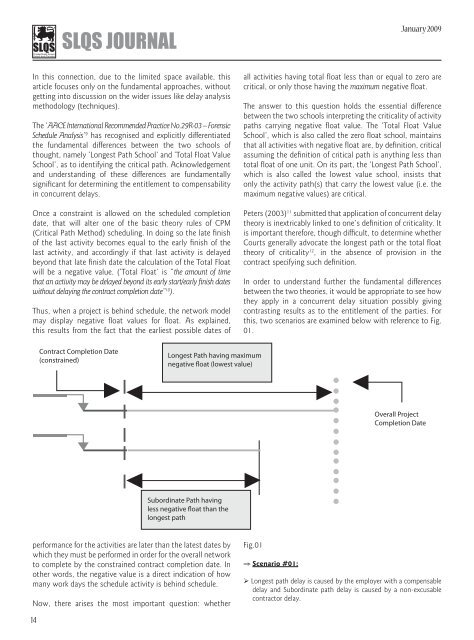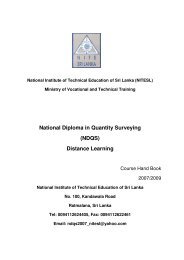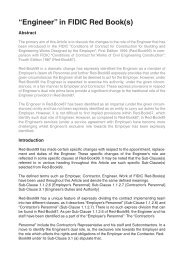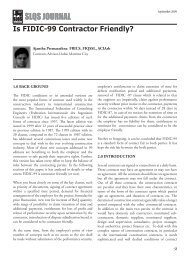<strong>SLQS</strong> JOURNALJanuary 2009In this connection, due to the limited space available, thisarticle focuses only on the fundamental approaches, withoutgetting into discussion on the wider issues like delay analysismethodology (techniques).The ‘AACE International Recommended Practice No.29R-03 – ForensicSchedule Analysis’ 9 has recognised and explicitly differentiatedthe fundamental differences between the two schools ofthought, namely ‘Longest Path School’ and ‘Total Float ValueSchool’, as to identifying the critical path. Acknowledgementand understanding of these differences are fundamentallysignificant for determining the entitlement to compensabilityin concurrent delays.Once a constraint is allowed on the scheduled completiondate, that will alter one of the basic theory rules of CPM(Critical Path Method) scheduling. In doing so the late finishof the last activity becomes equal to the early finish of thelast activity, and accordingly if that last activity is delayedbeyond that late finish date the calculation of the Total Floatwill be a negative value. (‘Total Float’ is “the amount of timethat an activity may be delayed beyond its early start/early finish dateswithout delaying the contract completion date” 10 ).Thus, when a project is behind schedule, the network modelmay display negative float values for float. As explained,this results from the fact that the earliest possible dates ofall activities having total float less than or equal to zero arecritical, or only those having the maximum negative float.The answer to this question holds the essential differencebetween the two schools interpreting the criticality of activitypaths carrying negative float value. The ‘Total Float ValueSchool’, which is also called the zero float school, maintainsthat all activities with negative float are, by definition, criticalassuming the definition of critical path is anything less thantotal float of one unit. On its part, the ‘Longest Path School’,which is also called the lowest value school, insists thatonly the activity path(s) that carry the lowest value (i.e. themaximum negative values) are critical.Peters (2003) 11 submitted that application of concurrent delaytheory is inextricably linked to one’s definition of criticality. Itis important therefore, though difficult, to determine whetherCourts generally advocate the longest path or the total floattheory of criticality 12 , in the absence of provision in thecontract specifying such definition.In order to understand further the fundamental differencesbetween the two theories, it would be appropriate to see howthey apply in a concurrent delay situation possibly givingcontrasting results as to the entitlement of the parties. Forthis, two scenarios are examined below with reference to Fig.01.Contract Completion Date(constrained)Longest Path having maximumnegative float (lowest value)Overall ProjectCompletion DateSubordinate Path havingless negative float than thelongest pathperformance for the activities are later than the latest dates bywhich they must be performed in order for the overall networkto complete by the constrained contract completion date. Inother words, the negative value is a direct indication of howmany work days the schedule activity is behind schedule.Now, there arises the most important question: whether14Fig.01⇒ Scenario #01:‣ Longest path delay is caused by the employer with a compensabledelay and Subordinate path delay is caused by a non-excusablecontractor delay.
<strong>SLQS</strong> JOURNALJanuary 2009• Outcome under ‘Longest Path Approach’: the contractor mayconsume negative float (created by longest delay) as long as thecontractor’s subordinate path finished earlier than the employer’slongest delay. He is not in a critical delay relative to the projectcompletion date which is set by the longest path, and also isentitled to recovery of extended overhead expenses for the entirelength of the longest path delay.• Outcome under ‘Total Float Approach’: Concurrent effect of delaysis considered and the contractor is granted extension of timeonly for the duration of the effect of subordinate delay; employerloses right to LAD – i.e. ‘Liquidated and Ascertained Damages’(or ‘penalty’) and contractor has to forego extended overheadsunless he can segregate costs from those caused by employerdelay. The contractor, however, is entitled to both time andmoney (in the form of extended overheads) for the remaining nonconcurrentperiod. In this outcome the employer does not haveto compensate for extended overhead costs for the entire longestpath delay period of employer’s compensable delay.⇒ Scenario #02:‣ Longest path delay is caused by the contractor with a nonexcusablecontractor delay and Subordinate path delay is causedby the employer with a compensable delay.• Outcome under ‘Longest Path Approach’: the employer mayconsume negative float (created by longest delay) as long as theemployer’s subordinate path finished earlier than the contractor’slongest delay. He is not in a critical delay relative to the projectcompletion date which is set by the longest path, and also isentitled to recovery of LAD (or ‘penalty’) for the entire length ofthe longest path delay.• Outcome under ‘Total Float Approach’: Concurrent effect of delaysis considered and the contractor is granted extension of time onlyfor the duration of the effect of subordinate delay; employer losesright to LAD (or ‘penalty’) and contractor has to forego extendedoverheads unless he can segregate costs from those caused byemployer delay. The employer, however, is entitled to recover LAD(or ‘penalty’) for the remaining non-concurrent period. In thisoutcome the contractor does not have to pay LAD (or ‘penalty’) forthe entire longest path delay period of contractor’s non-excusabledelay.The foregoing illustrates that if the ‘Longest Path Approach’ is adoptedthe delays on the other subordinate paths (which are delaying thecontract completion date to a lesser degree than the longest pathdelay) are considered non-critical relative to the (prevailing) overallproject completion date. In this instance, the effect of subordinateconcurrent delay would not permit to offset the compensability ofthe longest delay. However, if the ‘Total Float Approach’ is the oneadopted then all the delays (in the longest and the subordinate path)are considered ‘critical’ against the (prevailing) contract completiondate. In this case, the subordinate delay would permit to offsetthe compensability of the longest delay to the net extent of theconcurrency (subject to segregation of costs).Thus, in order to add certainty to the contract risk-distribution and foravoiding post-contract disputes the best solution is to conspicuouslyaddress the issue of ‘criticality’ in the contract itself. Thus, if thepreferred one is the ‘Longest Path Approach’ for criticality then itrequires to provide in the contract to assign total responsibility forcompensable delay to the party on longest path; if the inclinationis to use ‘Total Float Approach’ for criticality, then provide in thecontract to treat the net effect of concurrent delays is excusable onlyand not compensable.That said, it is interesting to note the position taken by the ‘SCLProtocol’. In its definition to ‘Delay to Completion’ it says that: “Incommon usage, the expression may mean either delay to the date when thecontractor planned to complete its works, or a delay to the contract completiondate. The Protocol uses the expressions Employer Delay to Completion andContractor Delay to Completion, both of which mean delay to a contractcompletion date..” 13 [Emphasis added]Also, it maintains that “ ..an EOT should only be granted to the extent thatthe Employer Delay is predicted to reduce to below zero the total floaton the activity paths affected by the Employer Delay.” 14 [Emphasis added]A delay analyst who is assigned to determine compensability inconcurrent delays requires appraising the fundamental differencesthat exist between the two theories of criticality. In the selection ofapproach for criticality, he should rely on the terms of contract todraw necessary inferences, or seek agreement of the parties if thatis called for.References1Bramble BB, Callahan MT, 2000, Construction Delay Claims, AspenPublishers, New York2Ibid3Ibid4The Society of Construction Law - Delay and Disruption Protocol’October 2002 – Appendix A5Tobin P, April 2007, ‘Concurrent and Sequential Cause of Delay’,TheInternational Construction Law Review , <strong>Vol</strong>ume 24( part 2), pp.143-1676Peters TF, 2003, ‘Dissecting the Doctrine of Concurrent Delay’, AACEInternational Transactions7Henry Boot Construction (UK) Ltd. v Malmaison Hotel (Manchester)Ltd. (1999), ConL R32; John Doyle Construction Ltd. V LaingManagement (Scotland) Ltd. [2002] BLR 393 (Outer House) and[2004] BLR 295 (Inner House)8(ref. 4 above) - Articles 1.4.1 and 1.4.79Published by ‘The Association for Advancement of Cost Engineering’,in USA in 2007.10(ref. 4 above)11(ref. 6 above)12In the US case authorities, Santa Fe Inc., VABC No.1943-1946decided in favour of ‘Longest Path approach’, whereas Toombs &Co. Inc., v United States, 4 Cl. Ct.535 (1984) decided for ‘TotalFloat approach’.13(ref. 4 above)14(ref. 4 above) - Article 1.3.1As submitted in the AACE International Recommended Practice No.29R-03 – Forensic Schedule Analysis, which approach is correct depends onwhich principles are considered.15





